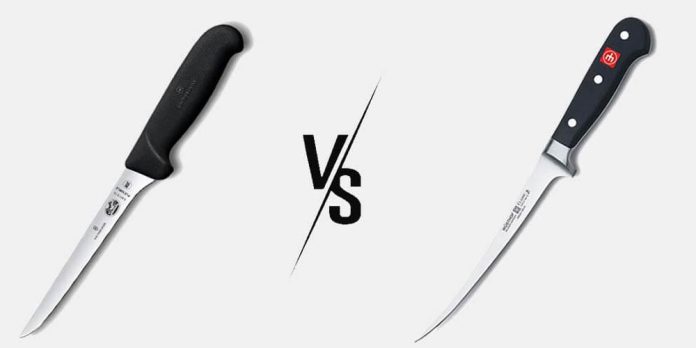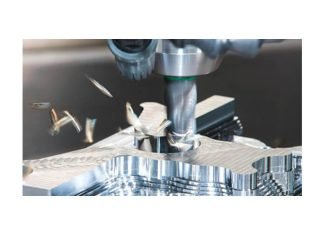You own a knife collection and are familiar with the various knives inside the set. The bread knife is easily visible, and the chef’s knife is always the one that is used more than any other knife. You could easily tell the difference between utility and paring knife. There are 2 types of knives that new chefs or even the ordinary person overlook, boning knife and fillet knife.
Unfortunately, those 2 knives are among the least well-known, even though they have become essential for food preparation. Both the boning or filet knife has curved edged blade, giving them a similar appearance. However, they’re not the same. Let’s take a closer look at these knives.
Boning Knife
A boning knife has a long and thin blade that ranges between 5 to 7 inches in length. The edge of the blade is always straight and also features a sharp, slightly curved tip. This knife is designed to cut hard meats and remove the meat and skin from bone, fat, and cartilage with ease. A boning knife may be used to remove bones from the fish as well as other foodstuffs, including fruits, veggies, and bakery items. Apple and mango cores may be sliced using boning knives.
Boning knives may be used to make creative shapes of baked items as well as curved cakes. Boning knives are used by a lot of bakers because of this. You may utilize them for cutting cookie dough as well as core cupcakes. A boning knife, on the other hand, cannot perform the same function as a fillet knife, and conversely.
Fillet Knife
A fillet knife is narrower and much more flexible as compared to boning knives and some other knives. The length of the blade is around 5 to 9 inches long and has an upward-curving curvature. The edge’s tip is extremely pointed and curved. But, if you try to remove the hard meat using it like you would use a boning knife, the blade would shatter due to its thinness.
A fillet knife works great for removing skin and scales off from the fish, and it could manoeuvre all-around tender flesh without damaging it. You may also use a fillet knife to swiftly and precisely slice fish into fillets. Although a boning knife may be used to remove the skin of fish, however, it would not offer the same results. If you’re using a boning knife rather than a fillet knife, you won’t get neatly cut pieces of fish. The final takeaway is that the boning knife performs better with harder meats or items which you could shape with it, and some fish cuts are too fragile for it. Fillet knives can be used to slice softer and lighter foodstuffs like fish.
Another distinguishing aspect of a fillet knife has been its long and shallow-angled edge. As a result, the blade becomes razor-sharp but not quite as strong as that of a boning or chef’s knife. As a consequence, this knife would not be seen at butcher shops since there’s no room for it.
Vegetables and fruit could be prepared using fillet knives. These knives may be used to slice lemons, oranges, and some citrus fruits, as well as remove the peels of fruits. If you like to have some fun sculpting fruit and veggies for decorating, a fillet knife can help.
Characteristics Of A Good Filet Knife And Boning Knife
A good filet knife and boning knife should have the following characteristics:
- The blades of both knives must be razor-sharp. It will make it simpler and easier to remove the flesh from the bones.
- Depending on the features you desire, you can choose blades made of high-carbon steel or stainless steel.
- If at all feasible, have a variety of blade sizes for filleting various types of fish.
- To avoid injury, make sure the knife’s grip is comfortable yet non-slip. Rubber, wooden, or plastic handles are also available.
Conclusion
Knives of both sorts are thinner as compared to knives of other types. As a result, they’re ideal for producing those intricate and accurate cuts. Whether you’re an ordinary cook or a professional chef, you’ll find that both of the knives are necessary.
However, while deciding between the boning and fillet knives, it’s crucial to remember that both of them have their own set of advantages and disadvantages. You must have both, ensuring that you can easily do whatever task is necessary.














